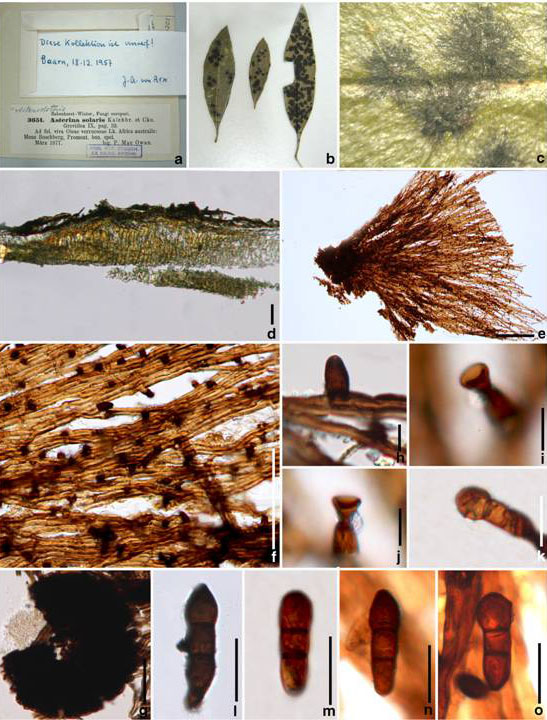Asterodothis solaris (Kalchbr. & Cooke) Theiss., Annls mycol. 10(2): 179 (1912).
≡ Asterina solaris Kalchbr. & Cooke, Grevillea 9(no. 49): 33 (1880)
= Asterostromina solaris Bat. & A.F. Vital, in Batista, Vital & Maia, Revta Biol., Lisb. 1: 116 (1957)
Isotype: K(M) 176514.
Epiphytes on the upper surface of the leaves, forming blackened 2–3 mm circular areas with radiating margins. Superficial hyphae 5–6μm (x = 5μm, n=10), with parallel radiations, with internmittent darker nodes, conical appressoria. Sexual state: Thyriothecia 193–335μm (x = 244μm, n=3), solitary or scattered, superficial around centre of hyphae group, solitary or scattered, easily removed from host surface, globose to subglobose, comprising brown to dark brown walled cells, rounded at the margin, ostiole centre, with a poorly developed basal layer. Asci and ascospores not observed. Asexual state: Asterostromina solaris (von Arx and Müller 1975). Conidophores 7–9μm diam. (x= 8μm, n=6), unbranched, brown conical to cylindrical, cup-shaped. Conidia 32–41×11–14μm (x = 34×12μm, n=10), 1–2-septate, constricted and dark at the septa, apical cell rounded and broader than lower cell, sometimes apical cell narrower and broader than lower cell, brown to dark brown, smooth-walled.
Material examined: SOUTH AFRICA, Cape of Good Hope, near Somerset East, Mount Boschberg, on surface of leaves of Olea europaea subsp. cuspidata (as Olea verrucosa) (Oleaceae), March 1877, P. Mac Owan (S-F49200).
Fig. 1 Asterodothis solaris (S-F49200). a Herbarium packet. b Herbarium specimen. c Fungal colony on substrate. d Section though colony. e, f Hyphae of thallus when viewed in squash mount. g Immature thyriothecia. h Darkened nodes on thallus hyphae. i, j Conidiophore. k Spore on conidiophorel. l–o Conidia. Scale bars: d=30μm, e=300μm. f= 100μm, h–j=10μm, l–o=20μm

